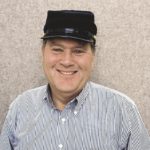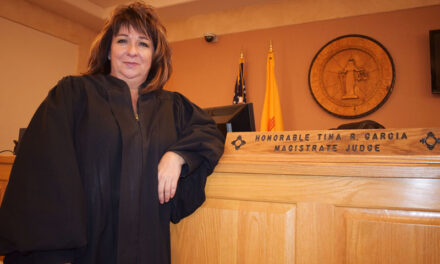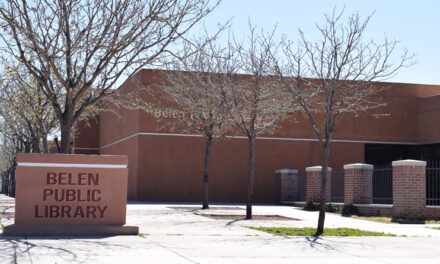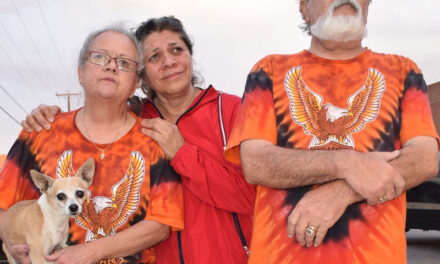In our first segment we introduced two of the prominent Jewish merchants in Valencia County—Moses Martin Sachs and Abraham Kempenich. This section introduces the third merchant, Simon Neustadt.
The family of Simon Neustadt
Simon Neustadt was born in Westphalia, Prussia, on June 11, 1858. He emigrated to the United States in 1879, ending up in Santa Fe.
In the fall of 1879, Neustadt came to Los Lunas, where he clerked in a mercantile business that was being run by his brothers, Samuel and Louis.
Samuel and Louis sold the business to Simon after three years, and he ran the store in Los Lunas before moving to El Paso. Meanwhile, Samuel opened a general store in the Armijo Hotel in Albuquerque, and Louis left New Mexico for New York.
In 1887, Simon returned to Los Lunas, where he purchased a general mercantile store from Louis and Henry Huning. His partners in the Los Lunas Mercantile Company were Mike Mandel and Leon Hertzog. The 1912 Illustrated History of New Mexico describes the operation thus:
Their store is 75 x 100 feet in dimensions. They have one wareroom 25 x 100 feet, and two other warerooms, each 50 x 75 feet. All are filled to their utmost capacity with the immense stock of general merchandise belonging to this company. Besides dealing in general merchandise, they handle wagons and farm implements of all kinds and a large amount of hay and grain, their chief market for hay and grain being Fort Wingate. All the members of the firm are men of marked business ability and experience, are liberal, honorable, and upright in their dealings, and are justly entitled to the enviable reputation which they have built up.
Neustadt’s 1891 passport application provides some interesting information about the young merchant. It notes that he was naturalized in El Paso in May 1890. He is described as 5-feet, 1-inch tall, with a high forehead, brown eyes and a “medium” nose. His hair is dark brown, his complexion is fair and he sports a mustache.
In 1890, Simon bought out L. F. Levy, whose store he occupied for 16 years, becoming one of the principal merchants of the town. In 1896, he was appointed postmaster.
In 1906, Neustadt hired Joseph Tondre to oversee construction of a new store on the southwest corner of Main Street and Los Lentes Road, the present location of Mondel Plaza. Neustadt had known the Tondre family for many years, and Joe was considered part of the Neustadt family, so much so that he is listed as an occupant of their household in the 1890 census.
The new store was the first building in Los Lunas with electric lights and running water. For a time, it also housed the post office.
Four large adobe warehouses were built behind the store to store hay and grain prior to shipment by rail to the Army at Fort Wingate. The store also had a coffin room in a small adjoining building, and cowboys who came into town for business (or pleasure) were allowed to sleep there.
Another resident listed in the 1900 census is William Wittwer, the newly-arrived physician.
A newspaper article from 1907 notes that Neustadt, Kempenich and another merchant named Kemp sold and shipped 60,000 bales of hay and thousands of pounds of wheat, all produce from local farmers.
The store was formally chartered in Santa Fe in June 1928 with ownership listed as Simon Neustadt, Joe Tondre and Frank Davila. Neustadt died shortly after the chartering on Nov. 14, 1928, and was buried in the Jewish section of Fairview Cemetery.
Tondre and Davila kept the store going under the “Simon Neustadt” moniker until 1946 when it was sold to a Cleveland businessman named Lionel Rosenbaum. Leo Haynes and his brother-in-law, Mickey Greenberg, purchased the store from Rosenbaum just one year later.
In 1957, Leo dissolved the partnership with Greenberg and formed a new one with Chester Skinner. This partnership dissolved in 1967, and Leo formed a new corporation with his son, Ken Haynes, still retaining the Neustadt name.
In 1962, the Haynes purchased land on the southeast corner of Main Street and Los Lentes and built a new 30,000 square-foot shopping center. In 1973, Ken took over the business and the store remained open until 1981.
By 1984, the building had been boarded up and was characterized as an “eyesore” along Main Street. A group of local businessmen persuaded the village to issue a $1.7 million industrial revenue bond to renovate the old facility into a 38,000 square-foot shopping center.
Orlando Montoya, one of the local businessmen, told the Albuquerque Journal even before the bond had been issued, the new facility, named Mondel Plaza for Orlando MONtoya and his wife, Jeanette DELgado, was 75 percent leased.
Ken Haynes had also purchased land across on the southeast corner Los Lentes and Main across from the old Neustadt building and built a new grocery store, which became one of his four Bag and Save stores, three of which were in Albuquerque. With the introduction of Bag and Save, the county had experienced the transition from barter economy to mercantilism to retail to big-box stores.
In addition, nearly 100 years of the Simon Neustadt name in Los Lunas had finally ended.
Jewish merchants originally came to Valencia County because of its rich agricultural foundation. Before the advent of the railroad in the 1880s, this area was a center of hay, wheat and sheep production for the entire territory.
In addition, it was a major area supplying the Army, even before Ewell established his post in Los Lunas in 1852. The three merchants we profiled — Moses Sachs, Abraham Kempenich, and Simon Neustadt — and their families contributed much to the growth and development of Valencia County during the 19th and early 20th centuries, yet they are all but forgotten.
Their stores and homes are gone, and their names are seldom mentioned. However, the legacy of their mercantilism is still felt in the economic growth and success in Valencia County.
(La Historia del Rio Abajo is a regular column about Valencia County history written by members of the Valencia County Historical Society. The author of this month’s column is John Taylor, a retired engineer from Sandia National Laboratories and board member of the Valencia County Historical Society. He is the author or co-author of twenty-five books on New Mexico. Opinions expressed in this and all columns of La Historia del Rio Abajo are the author’s only and not necessarily those of the Valencia County Historical Society or any other group or individual.)









